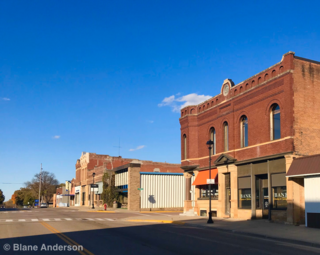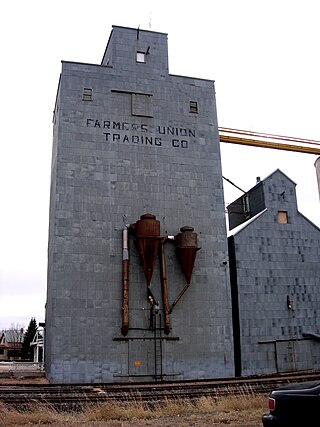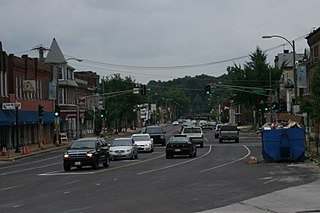
Sheridan County is a county in the U.S. state of Montana. As of the 2020 census, the population was 3,539. Its county seat is Plentywood. Its northern boundary is the Canada–United States border south of Saskatchewan.

Calamus is a small town in Clinton County, Iowa, United States, located on the historical Lincoln Highway, which was the first transcontinental highway for automobiles across the U.S.. Calamus is the only town in Olive Township and had a population of 356 at the 2020 census, which was a 9.6% decrease from 2000. Calamus was named after Calamus Creek, which received its name from the great quantities of sweet flag growing in it, derived from the botanical name Acorus calamus, commonly called Sweet Flag or Calamus.

Lake Crystal is a city in Blue Earth County, Minnesota, United States, established in 1869. The population was 2,539 at the 2020 census. It is part of the Mankato-North Mankato Metropolitan Statistical Area.

Bearcreek is an incorporated town in Carbon County, Montana, United States. It is part of the Billings, Montana Metropolitan Statistical Area. The population was 91 at the 2020 census. Bearcreek uses the Mayor/Council form of government.

Livingston is a city and county seat of Park County, Montana, United States. It is in southwestern Montana, on the Yellowstone River, north of Yellowstone National Park. As of the 2020 census, the population of the city was 8,040.

Antelope is a census-designated place (CDP) in Sheridan County, Montana, United States. The population was 51 at the 2010 census.

Plentywood is a city in and the county seat of Sheridan County, Montana, United States. The population was 1,669 at the 2020 census.

Hysham is a town in and the county seat of Treasure County, Montana, United States. The population was 276 at the 2020 census.

Chapin, popularly known as the "Capital of Lake Murray", is a small lake town located at the northern tip of Lexington County, South Carolina, United States. Lake Murray separates Chapin from the rest of Lexington County. The population of Chapin was 1,445 according to the 2010 census, and an estimated 1,633 in 2019.

Elkhorn is a census-designated place (CDP) in Jefferson County, Montana, United States, in the Elkhorn Mountains of the southwestern part of the state. As of the 2010 census it had a population of 10. The community is considered a ghost town, and two of its buildings are preserved as Elkhorn State Park.

Lafleche is a small town in southwest Saskatchewan, Canada in the Rural Municipality of Wood River No. 74. The community is located at the intersection of Highway 13 and Highway 58. It is 20 km south of Gravelbourg and 45 km west of Assiniboia. It is situated on the south bank of Lafleche Creek, which is a tributary of Wood River. Thomson Lake Regional Park is located 10 minutes north of town.

Rapelje is an unincorporated community and census-Designated Place in northern Stillwater County, Montana, United States. Rapelje was named for J. M. Rapelje, general manager and vice president of the Northern Pacific Railway. Rapelje had a population of approximately 110 people as of the 2000 census. Rapelje is located 24 miles north of Columbus on Montana Secondary Highway 306.
Rockglen is a town in the Burning Hills of the Wood Mountain Uplands, in Saskatchewan, Canada. It offers various amenities including a school, community hall, public library and five parks, as well a local service industry. The municipal office of the Rural Municipality of Poplar Valley No. 12 lies within the boundaries of Rockglen, and Rockglen businesses are supported primarily by agriculture. In the Burning Hills agriculture consists of dry land farming and cattle. Rockglen is located along Highway 2 south of Assiniboia, Highway 18 west of Coronach, and Highways 2 and 18 north of Port Poplar River. Fife Lake is 9.3 kilometres (5.8 mi) to the east.
Glasston is a farming town located in Saint Thomas Township in North Dakota's Pembina County, United States. It consists of a post office, a general store, and a handful of houses. It was established in 1886 as a station along the Great Northern Railroad. Originally called Baltimore, the site was later renamed for Archibald Glass, its first postmaster. The population of the village has rarely exceeded 100 since it was established.

Baden is a neighborhood of St. Louis, Missouri.

Maybutt, also known as "New Stirling" or "New Town", is a former locality in the County of Warner No. 5, Alberta, Canada. The community is situated 1 km north of the Village of Stirling just off the CANAMEX Corridor between Lethbridge and the Canada–US border. The community has become a bedroom community to Lethbridge, with many newer acreages being developed in the area. The footprint of Maybutt is defined by its historic boundary roads, Young St., Sunnyside Ave., Front St. & Lorne Ave, and Etzikom Ave. York St., First Ave. and Second Ave. are the only interior streets left of the original street grid of Maybutt.
Radium is an unincorporated community in section 19 of Comstock Township, Marshall County, Minnesota, United States. It was built alongside the Minneapolis, St. Paul and Sault Ste. Marie Railroad branch line built in 1905 from Thief River Falls, Minnesota, to Kenmare, North Dakota. The place was named for the element radium. Radium had its own post office from 1905 to 1984. Since 1984, Radium has been served by the post office in Warren. It is also on the Warren telephone exchange and part of the Warren-Alvarado-Oslo school district. The townsite is being slowly reclaimed for use as farmland. There is still a large grain elevator on the railroad line south of the townsite. A small Lutheran church 1+1⁄2 miles (2.4 km) south of the town antedates the coming of the railroad; Immanuel Lutheran Church (LCMS) was organized in 1897.

Mondak is a ghost town in Roosevelt County, Montana, United States, which flourished c. 1903–1919, in large measure by selling alcohol to residents of North Dakota, then a dry state.

Miles City is a city in and the county seat of Custer County, Montana, United States. The population was 8,354 at the 2020 census.

Horizon, located on the south side of Channel Lake, is a hamlet in Bengough Rural Municipality No. 40, Saskatchewan, Canada. It previously held the status of village until December 31, 1973. The hamlet is located 60 km (37 mi) east of the Town of Assiniboia on highway 13.



















